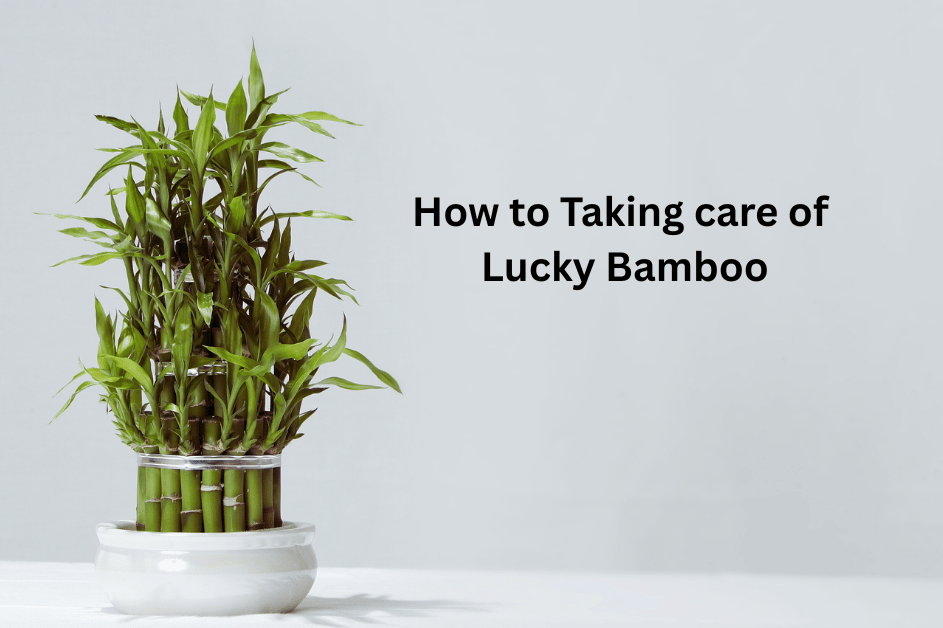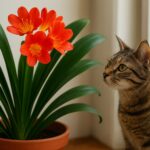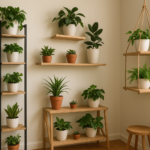Lucky bamboo (Dracaena sanderiana) is one of those plants that instantly catches the eye. Despite its name, it’s not true bamboo but a resilient tropical plant that has become a household favorite for its beauty and symbolic meaning. Known for bringing luck, prosperity, and positive energy, it’s widely used in homes and offices. The best part? It doesn’t demand much—just a little care and attention can keep it thriving for years. Whether you grow it in water or soil, this plant can be your green companion with minimal fuss.
The Symbolism Behind Lucky Bamboo
Lucky bamboo is deeply rooted in Feng Shui traditions. Each arrangement of stalks carries a unique meaning—like three stalks symbolizing happiness, wealth, and longevity, while six stalks represent prosperity. Many people place it in homes or workplaces to attract good energy, peace, and growth. It’s often gifted on special occasions like housewarmings, business openings, or birthdays as a token of good fortune. Beyond symbolism, its lush green appearance adds a sense of calm and elegance to any setting.
About Lucky Bamboo

Lucky bamboo (Dracaena sanderiana) is a popular ornamental plant known for its elegance, resilience, and symbolic meaning. Despite its name, it is not a true bamboo but a tropical plant native to Africa and Asia. Its vibrant green stalks and delicate leaves make it a favorite for home and office décor.
This plant is highly adaptable, able to grow in water or soil, and requires minimal care, making it perfect for beginners. In addition to its aesthetic appeal, lucky bamboo is believed to bring good luck, prosperity, and positive energy according to Feng Shui traditions. Its growth patterns can symbolize various aspects of life, depending on the number of stalks in an arrangement.
Different Types of Lucky Bamboo Arrangements
Single Stalk
A single stalk arrangement represents simplicity and strong growth. It’s ideal for personal use and symbolizes unity.
Two Stalks
Two stalks are usually gifted to couples as they symbolize love and partnership.
Three Stalks and More
Three stalks bring happiness, wealth, and longevity. Higher numbers, like five or eight, amplify prosperity and abundance. Spiral and tower arrangements are popular decorative variations that enhance both energy and beauty.
Ideal Growing Conditions
Light Requirements
Lucky bamboo thrives in bright, indirect light. Direct sunlight can scorch its leaves, while low light slows growth. A spot near a window with filtered light is perfect.
Temperature Needs
Keep the plant in a warm environment, ideally between 65–90°F (18–32°C). Avoid placing it near vents, heaters, or air conditioners.
Humidity Preferences
Since it’s a tropical plant, lucky bamboo enjoys moderate to high humidity. Misting occasionally helps keep it fresh.
Soil vs. Water Growing Methods

Lucky bamboo is versatile and can thrive in water or soil, depending on your preference. Each method has its advantages, and understanding them helps you choose the best setup for your home.
Growing in Water
Water-grown bamboo is the most common and low-maintenance method. Place the stalks in a vase with distilled or filtered water and use pebbles for support. Change the water every 1–2 weeks to prevent stagnation and algae growth. This method allows you to see the roots develop, making it both decorative and easy to care for.
Growing in Soil
Soil-grown lucky bamboo provides more stability and access to nutrients. Use a well-draining potting mix and keep it slightly moist but not waterlogged. Soil growth can encourage stronger root systems and is ideal for long-term cultivation.
Choosing the Right Container
The container affects both the plant’s growth and aesthetic appeal. For water-grown bamboo, glass vases are popular as they showcase the roots and pebbles. For soil, choose ceramic or plastic pots with drainage holes to prevent root rot. Ensure the container is large enough to accommodate root expansion and provides stable support for the stalks.
How to Water Lucky Bamboo Properly

Proper watering is essential for healthy bamboo. Use distilled or filtered water to avoid chlorine and fluoride. In water arrangements, keep the roots fully submerged and refresh water every 1–2 weeks. For soil-grown bamboo, water when the top inch of soil feels dry, ensuring the soil remains moist but not soggy. Avoid overwatering, as this can cause root rot. Regularly cleaning the container also prevents bacterial growth and keeps your plant vibrant.
Fertilizing Your Lucky Bamboo
Lucky bamboo is a low-maintenance plant that doesn’t need heavy feeding, but a little fertilizer goes a long way in keeping it healthy. Use a liquid houseplant fertilizer or one specially made for hydroponic plants, as lucky bamboo often grows in water. A few drops once a month are usually enough. For soil-grown bamboo, dilute the fertilizer to half strength and apply during watering.
Be careful not to over-fertilize, as this can cause yellow leaves or burnt roots. If you notice yellowing after feeding, flush the container with clean, distilled water to remove excess fertilizer. Regular but light feeding ensures your lucky bamboo stays vibrant, green, and strong without stress.
Pruning and Shaping Lucky Bamboo
Pruning keeps lucky bamboo neat, healthy, and visually appealing. Use clean, sharp scissors to trim yellowing leaves or overgrown shoots. Always cut above a node (the ring on the stalk) to encourage new growth. Avoid cutting the main stalk, as this can weaken the plant.
Shaping lucky bamboo adds charm and uniqueness. To create spirals, place the plant near a light source and rotate it slowly every few days—bamboo naturally bends toward light. For more creative designs like braids or twists, guide young shoots using ties, wires, or supportive frames. Commercial growers often achieve complex shapes with controlled light exposure, but with patience, you can train your plant at home.
Regular pruning not only maintains a tidy appearance but also stimulates healthy growth. Shaping, on the other hand, lets you turn your lucky bamboo into living art that brings both beauty and positive energy to your space.
Repotting Lucky Bamboo
Repotting lucky bamboo is important when the plant outgrows its container or roots become crowded. Signs it’s time include roots circling the vase, slow growth, or water turning dirty too quickly. To repot, gently remove the stalks and rinse the roots under clean water. If growing in water, transfer the plant to a larger vase, add fresh pebbles for support, and refill with distilled or filtered water. For soil-grown bamboo, choose a pot with drainage holes and fill it with a well-draining potting mix. Place the stalks upright and water lightly. Repotting not only gives the roots more space but also refreshes the environment, helping your lucky bamboo stay healthy and vibrant.
Common Problems and Solutions

Even though lucky bamboo is easy to care for, it can sometimes show signs of stress. Here are common problems and how to fix them:
- Yellow Leaves – Usually caused by too much sunlight, excess fertilizer, or poor-quality water. Solution: Move the plant to indirect light, use distilled/filtered water, and stop fertilizing for a few weeks.
- Mushy Stems – A sign of root rot from overwatering or stagnant water. Solution: Cut off damaged stems, place healthy stalks in fresh water, and clean the container thoroughly.
- Algae Growth – Happens in clear containers exposed to light. Solution: Switch to an opaque vase or add decorative stones to limit light exposure.
- Brown Tips on Leaves – Often due to dry air or chemicals in tap water. Solution: Increase humidity by misting and always use chlorine-free water.
- Slow Growth – May be caused by low light or lack of nutrients. Solution: Move the plant to a brighter spot and feed lightly once a month.
By addressing these issues early, you can revive your lucky bamboo and keep it thriving. Regular care and quick action are the keys to maintaining a vibrant, healthy plant.
Lucky Bamboo Feng Shui Placement Tips
Feng Shui traditions link lucky bamboo to harmony, prosperity, and balance. Placement is key to maximizing its energy. Put it in the east to encourage family health and unity, or in the southeast to attract wealth and financial luck. A small arrangement on your work desk can boost focus and career growth. Avoid placing it in bathrooms, cluttered spaces, or dark corners, as these reduce positive energy flow. Using red ribbons, gold coins, or decorative vases further enhances its Feng Shui effect. With the right placement, lucky bamboo becomes more than décor—it’s a symbol of abundance.
How to Propagate Lucky Bamboo
Propagating lucky bamboo is simple and rewarding. Select a healthy stalk with at least one leaf joint (node). Cut the stalk just below a node using clean scissors. Place the cutting in a container of distilled water, ensuring the node is submerged. Within a few weeks, roots will sprout from the cut section. Once roots are strong, you can either keep the new stalk in water or transfer it to soil for long-term growth. Always keep water fresh and avoid direct sun during propagation. This method helps you multiply your plant and share its luck with others.
Seasonal Care Adjustments
Lucky bamboo needs small seasonal tweaks to stay healthy year-round. In summer, the plant grows faster, so increase watering frequency and change the water every week to prevent algae. Keep it away from direct sunlight, as strong rays can scorch the leaves. In winter, growth slows, so reduce water changes to every two weeks and avoid overwatering. Protect the plant from cold drafts, heaters, or windows with frost. During spring and fall, continue regular care but watch for temperature shifts. By making these simple adjustments, you’ll help your lucky bamboo thrive no matter the season.
Lucky Bamboo Safety for Pets
Lucky bamboo may look harmless, but it’s considered toxic to cats and dogs. If chewed or ingested, it can cause drooling, vomiting, weakness, and lack of appetite in pets. The plant contains compounds that irritate their digestive system, leading to discomfort and possible health issues. To keep your furry friends safe, always place it out of reach—on shelves, desks, or enclosed containers. If you suspect your pet has eaten any part of the plant, contact your veterinarian immediately. While lucky bamboo brings beauty and good fortune to your home, it’s best enjoyed away from curious paws.
Tips to Keep Looking Fresh and Healthy
- Use filtered or distilled water – avoids chlorine and fluoride damage.
- Change water regularly – every 1–2 weeks to prevent algae.
- Wipe leaves gently – removes dust and helps photosynthesis.
- Keep in indirect light – too much sun burns leaves.
- Trim yellow leaves – promotes fresh growth.
- Rotate the plant – ensures even growth.
- Clean container and pebbles – prevents bacteria buildup.
- Avoid over-fertilizing – just a few drops monthly.
Conclusion
Taking care of lucky bamboo is simple, yet the rewards are plenty. Not only does it add beauty to your space, but it also brings positive vibes and good fortune. With just the right light, water, and occasional care, your plant can thrive for years. Whether grown in water or soil, lucky bamboo is more than just a plant—it’s a symbol of balance, prosperity, and peace.
FAQs
1. How often should I change the water in lucky bamboo?
Every 1–2 weeks to prevent stagnation and algae growth.
2. Can lucky bamboo survive in low light?
Yes, but it grows slower. It thrives best in bright, indirect light.
3. Why are my lucky bamboo leaves turning yellow?
Likely due to excess fertilizer, direct sunlight, or poor-quality water.
4. Can I grow lucky bamboo outdoors?
Yes, in warm climates with shade. Avoid frost exposure.
5. How long does lucky bamboo live?
With proper care, it can live 10 years or more indoors.







